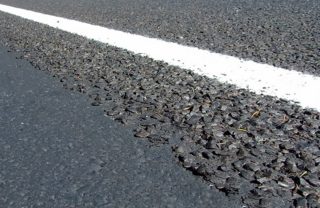
(Photo: Peckham Asphalt)
For the first time ever, the Oregon Department of Transportation has published their list of upcoming chip seal projects specifically with bicycle riders in mind.
Chip seal is a type of paving material that mixes asphalt with pieces of fine aggregate (a.k.a. gravel). Road agencies love it because it extends the life of low-volume rural roads and it’s much cheaper to do than repaving. But for people who bike, chip seal is a drag. Literally. The tiny bumps don’t even register while driving, but on a bike they can really slow you down and cause fatigue. (And you do not want to think about what happens when you crash on it.) What makes matters worse is that road crews will often chip seal just the standard lane and then leave a ridge that crosses the fog line and goes into the shoulder people ride.
“My goal is to get the word out so bicyclists can plan accordingly and avoid an unhappy experience.”
— Sheila Lyons, ODOT Bicycle and Pedestrian Program Coordinator
Because of the groans that come with chip sealed roads, we were happy to get an email from Oregon’s Bicycle and Pedestrian Program Coordinator Sheila Lyons last week. She wanted to make sure people know what to expect when planning summer bike adventures on our state’s many excellent backroads. Lyons knows this is an issue, not just because she hears about it from Oregonians, but because she’s a rider herself. “It can be no fun to ride on,” she wrote in the email. “But it’s a cheap and effective surfacing treatment that ODOT is using more and more.”
Advertisement
Every summer ODOT publishes a map of all their upcoming projects, so Lyons asked each district manager where they planned to lay down chip seal. Then she created a handy list (below). “It’s used largely on lower volume rural roads – those that we like to bike on,” she wrote. “My goal is to get the word out so bicyclists can plan accordingly and avoid an unhappy experience.”
You’ll note that of the 26 projects, six of them run through an Oregon State Scenic Bikeway. Keep this list in mind — and also check the map for other projects across the state — when making trip plans. Also remember that these projects are subject to change. For the latest information, call the local ODOT district office.
— Jonathan Maus, (503) 706-8804 – jonathan@bikeportland.org
Our work is supported by subscribers. Please become one today.



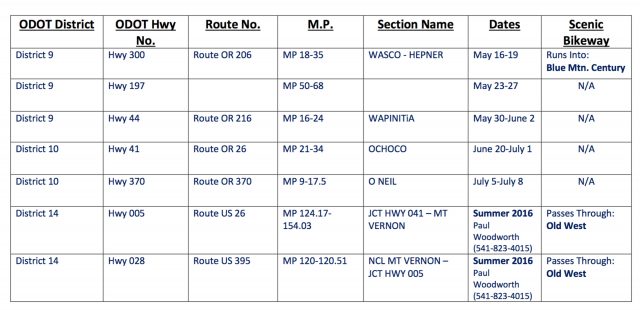
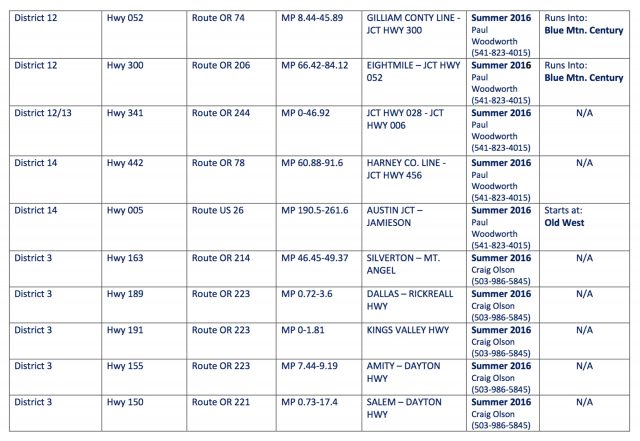
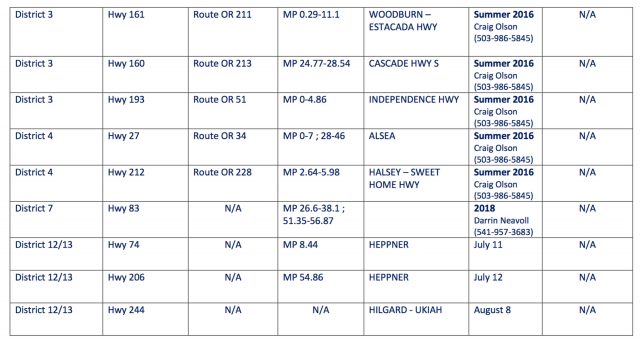



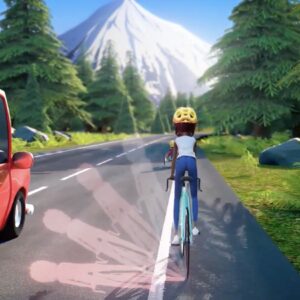
Thanks for reading.
BikePortland has served this community with independent community journalism since 2005. We rely on subscriptions from readers like you to survive. Your financial support is vital in keeping this valuable resource alive and well.
Please subscribe today to strengthen and expand our work.
Well that’s thoughtful of them!
Now, if only there was a way of assembling all the numbers and words from the chart into something which a normal person could easily see and decode in a quick glance… Oh yeah, A map.
I recall reading that ODOT’s policy on chipseal is to not put it on shoulders that are appropriate to cycle on (yes, there are a few of these). Unfortunately, all counties that I have ridden in as well as ODOT itself ignore that directive and spread the goo everywhere. At this point, I am down to hoping they will simply repair the long wheel-eating cracks in the pavement prior to chipsealling.
As far as riding on chipseal, one can reduce discomfort as well as rolling resistance by using the widest most supple tires that fit on the bike. Sure, there’s a small weight penalty that can be felt on accelerations, particularly while climbing, but the decreased rolling resistance and ability to casually take on gravel more than makes up for that.
Time to get another and very different kind of bike. The widest tire I can get on either of mine is a 28, and I don’t overinflate.
And who says ODOT hates bikes. See how they are encouraging bike purchases with their decisions. 😉
28mm Maxxis “re-fuse” at 60psi is pretty good on our SW streets (rubble) for 200lb me on a cro-mo fixed-gear. Not sure how the fender clearance would be with tar involved.
I was once brought to a dead stop when a loose bit of gravel from a fairly recent chip seal project lodged between tire and fender. I was climbing at low speed so no disaster, just a surprise that I could go any slower
My friend is an engineer for a city near Portland, and several years back he said, “When I look at our road budgets, I see a lot of chip-seal in our future, and thus a titanium bike with wide tires.” Back then I thought it was just his rationalization (and negotiation with his wife) for the expenditure, but I think he might have been onto something. (He now rides a custom Guru Ti with 28s).
Sounds like he forgot the wide tires. 😉
It’s because of him I’m up to 25s from 18s! 🙂
Most supple tires? That surprises me. Wouldn’t the flex of the rubber make them far more resistant to rolling? I assumed you want hard tires (for resistance reasons, obviously it’d be very uncomfortable to ride on coarse chip seal).
Wider, lower pressure tires will absorb more road vibrations. I run 47c tires at 45 PSI on my commuter and it’s like riding on a cloud.
“Supple” tires have flexible sidewalls which are LESS resistant to flexing, so they have lower rolling resistance, even at moderate pressures. They work particularly well on rough surfaces (like chipseal), where a narrow, high-pressure tire will tend to bounce along, wasting some energy.
Narrow, high-pressure tires are the best on a perfectly smooth, wooden track, but on rough roads a wider tire will have lower rolling resistance, as long as the casing is made of good-quality, flexible material.
Also, I’ve compared 28s on an 18mm rim versus 23s and 25s on a 23mm rim (Pacenti SL-23, similar to HED Belgium), and the wide rims make for a noticeable improvement in comfort. (Tires were all Vittora Rubino Pro III).
Is it possible for ODOT to at least consider using a finer grain of chip seal on the segments that are officially parts of Scenic Bikeways?
In Wisconsin they chip seal but use 1/4″ minus aggregate. Those roads are like butter compared to the mess they made of Rood Bridge Rd, part of the scenic bikeway.
My guess is that Oregon is using larger aggregate as a way to extend the life of the chip seal because studded tires are allowed to be used on these roads. I’ve also noticed an increase in the aggregate size specified for normal asphalt, most likely for the same reason.
The roads I’ve seen chip sealed that impact me as a cyclist, are not high use roads where studded tires were an issue. An example would be Kerkman Rd in Wash Co. , 1.5mi in length, a total of 6 houses on the road, the heaviest traffic is during the wheat harvest, otherwise it was a smooth piece of asphalt, minor if any cracking, no deterioration of the edges, a joy to ride. And that road got chip sealed. Do they actually inspect these roads before doing the work, or are they on some schedule and it just gets ticked off the list when it’s “DUE”.
A common misperception. Chip seal is preventative and has to be done before the pavement begins to degrade.
Or you can decide that it hasn’t reached a point requiring chip seal save the $$ and do a proper paving job. Chip seal has come about because it is cheaper than a real resurface.
But go look at other chip seal jobs, like West Union Rd. Sure they chip sealed but they didn’t resolve any of the pot holes and edge deterioration, they just “sealed” over it. Which does nothing to resolve issues with water penetration which caused the pot hole in the first place. Sealing over cracked and broken down edges doesn’t slow further degradation of the road surface.
Meant to say a proper paving job 2 years later.
Anxiously awaiting a “Chipseal-specific” bike from one of our local builders. I’m sure Specialized will have one eventually.
If you think it’s bad on your bike try it with skateboard wheels. For just a little more they could apply sealcoat on the shoulder to fill the gaps.
you might want to revisit with ODOT what kind of chip seal is proposed.
Chip seal in Portland uses very fine aggregate, not gravel.
Fog seal uses sand, if any aggregates.
I was told in the Portland Traffic and Transportation class that Portland uses slurry seal, not chip seal.
Cured chip seal is fine with me. It is the fresh stuff after they lay it down but before they sweep up the excess that is horrible and dangerous. Literally like riding on pavement covered in gravel. Will be good to know how to avoid that mess.
Looks like I’ll have to take Paul Woodworth for a ride out to Heppner on Eightmile with me sometime soon…
Every road I trained on in my youth was chip, or gravel. August 112 degrees, 72% humidity, fresh road seal… awesome! That’s living!
It would be nice if ODOT cared enough about people outside of cars to even add bike facilities (not shoulders) and sidewalks to their roads. How long does it take to rebuild a very small, dangerous area on a state highway in an urban area? Last I heard, no one at ODOT even cares about Lombard anymore and they aren’t willing to fix it to make it safe.
Ethan,
that’s a rather vague request. Can you be more specific?
Last I recall, Lombard had sidewalks in most of the urban area.
six foot sidewalk and curb costs about $300 per foot to build, one side of the road.
six foot of roadside space, like for a bike lane, costs about $132 per foot.
Right of way costs are extra, as are drainage management ($$$$).
There’s a bike lane gap near 42nd and there are no sidewalks on the part of Lombard I live by. I would call that at least somewhat urban, given that it’s in Portland And goes by schools, houses and apartments.
The phrase “plan accordingly” sounds like a polite way of telling us to F-off, that they’re going to do whatever they want to any road they choose to ruin for cycling, and they don’t care if we like it or not.
As for changing tire width and inflation, has it occurred to anyone that we don’t always ride on chip-seal, or always not? What are we supposed to do if we’re on chip-seal part of the time and a decent road surface the rest of the time? I don’t have self-adjusting tires or a follow car with spare bikes and wheels, do you?
You need to ride a bike that can handle the worst conditions you will encounter. It’s not really that bad. The weight penalty for wide supple tires is less than a full water bottle (and a lot less than the extra weight on my engine) and has almost no impact unless you are actively racing where uphill accelerations are important.
That said, it sucks that so many people have purchased very expensive bikes over the past twenty years that simply don’t have enough clearance for the tires they now need to ride on due to our ever-lower road quality. I guess it’s n+1 time.
I agree that the bike industry has done a disservice to recreational cyclists by pushing racing bikes so hard. Race cars are unsuited to a lot of public roads, and so are race bikes. If people want to put 23c tires on their bike fine, but there’s almost no real world performance penalty to creating a bike with enough clearance for 32c (or even larger) tires, even if it’s supplied with skinnier ones.
I always advise people who are considering buying road bikes to at least consider a cyclocross bike. You can always put skinnies on it if you want, but you’ve got a lot more options that way. (Personally, as a path-less-traveled guy I would never again consider riding something with less than 32mm tires anyway, but I understand some people want that tiny extra increment of speed).
Could not agree with this more. Another benefit to riding a more sensible bike with wider tires is reduced threat from streetcar tracks.
My wife is riding LIT 28s on her 2010 Masi 3VC and they barely fit. She was nearly hit from the side so I got her reflective sidewalls, and since they’ve been rubbing I recently built up a Cannondale CAAD-X for her. But she loves her Masi so much, and now that it’s light out for her commute we put the 25s back on – and it turns out I’m really digging this little Cannondale anyway! I geared it low so I use it to climb with 25s on Reynolds 32C rims that I rebuilt with disc hubs, and it also fits 32c cross tires on 29er rims so we can ride off-road together with her using my MTB. So many good frames out there now, and it’s a shame I didn’t know what I didn’t know just a few years ago!
Nice article about real world cycling.
Narrow high pressure tires are for racing, other than a couple triathlon legs I’ve never been in a bike race. Too bad the bike shops push gear that isn’t suited for real world cycling. Makes them money, but results in a lot of dusty bicycles.
I have 2 race bikes that only take 28’s, smaller with fenders and that sucks and means I don’t ride them except in summer, I ride touring bikes more, but 47 dude, what are you trying to prove?. 32 will is good enough, virtually eliminates flats and good comfort, lower pressure.
My best advice to a beginning cyclist is talk to other cyclists with experience, but commuters or tourists, not racers, if you can find one. I’ve never actually met a “racer” whose actually currently racing.. Ignore the bike shop and never take advice online from those dumb magazines. All they sell is bad advice to waste money on gear that’s, inappropriate for most situations, unreliable and expensive.
I see bikes on club rides that look like truly miserable bikes to ride or Cycle Oregon, I think carbon is just a con, planned obsolence, a bike frame should never wear out. I’ll never buy another carbon bike frame.
Over 5K hard miles on my 2013 Masi Evoluzione and no problems with any of my carbon frames yet, but I guess it depends on the layup. You’re right, 28s and 32s are fine for more comfortable riding, especially on wider rims as I mention above. Skinny tires at high pressure, as John Liu mentions below, do have their place in climbing and acceleration, but even in time-trialing pros are starting to go with wider tires/rims for improved contact patch, especially on the rear of the bike.
Once I was riding 23s at 125 psi on narrow carbon clinchers (Reynolds C32), and got my best time up a steep local hill, followed by a record descent (was playing with disc brakes – how late I could brake when setting up for turns). Problem was, on the last switchback, the stiff, narrow tire setup caused the rear wheel to lose grip and try to pass me on the left, making for a very abrupt crash, and helmet split in two. So yeah, skinny tires have some advantages, but I’m no longer a believer in them. (23mm rims with 25s feel better than 28s on 18mm rims to me).
I have bikes with 23 mm tubulars and bikes with 42 mm Hetres. There is a use and purpose for every bike.
Skinny tires can be very light, and can ride on very light rims. The advantage of that is that you can accelerate faster and climb with less effort. Does that matter? To some, yes. The disadvantage is that the skinny tires will be pumped up hard, at 120 psi, and won’t be as comfortable as wider tires can be. Does that matter? To some, no. I’ve ridden centuries on 23 mm tubulars, and did so happily.
For general around town “utility” riding (commuting, errands, shopping, etc), with no particular desire to be fast or quick, I think 32 mm is ideal. That’s what I put on my friends’ around town bikes. Reflective sidewalls are a really good idea.
Wider than 32 mm, the tires I know of are either really heavy and slow, or expensive ($50+ per).
Washington County’s chip seal plans for summer 2016 are posted here:
http://www.co.washington.or.us/LUT/News/chip-seals-2016.cfm
CalTrans did a lot of experimenting with chip seals to try to find one that worked to extend road life and was “kind” to cyclists. If I remember correctly they found two solutions, one that was a sand-heavy slurry and the other that used really fine aggregate (1/8″ to 1/4″) with a slightly higher ratio of asphalt. The sand slurry was also found to be better for pavements that had started to “alligator crack” is it filled the cracks preventing further degradation.
Specialized tricross. Run whatever tire you want.